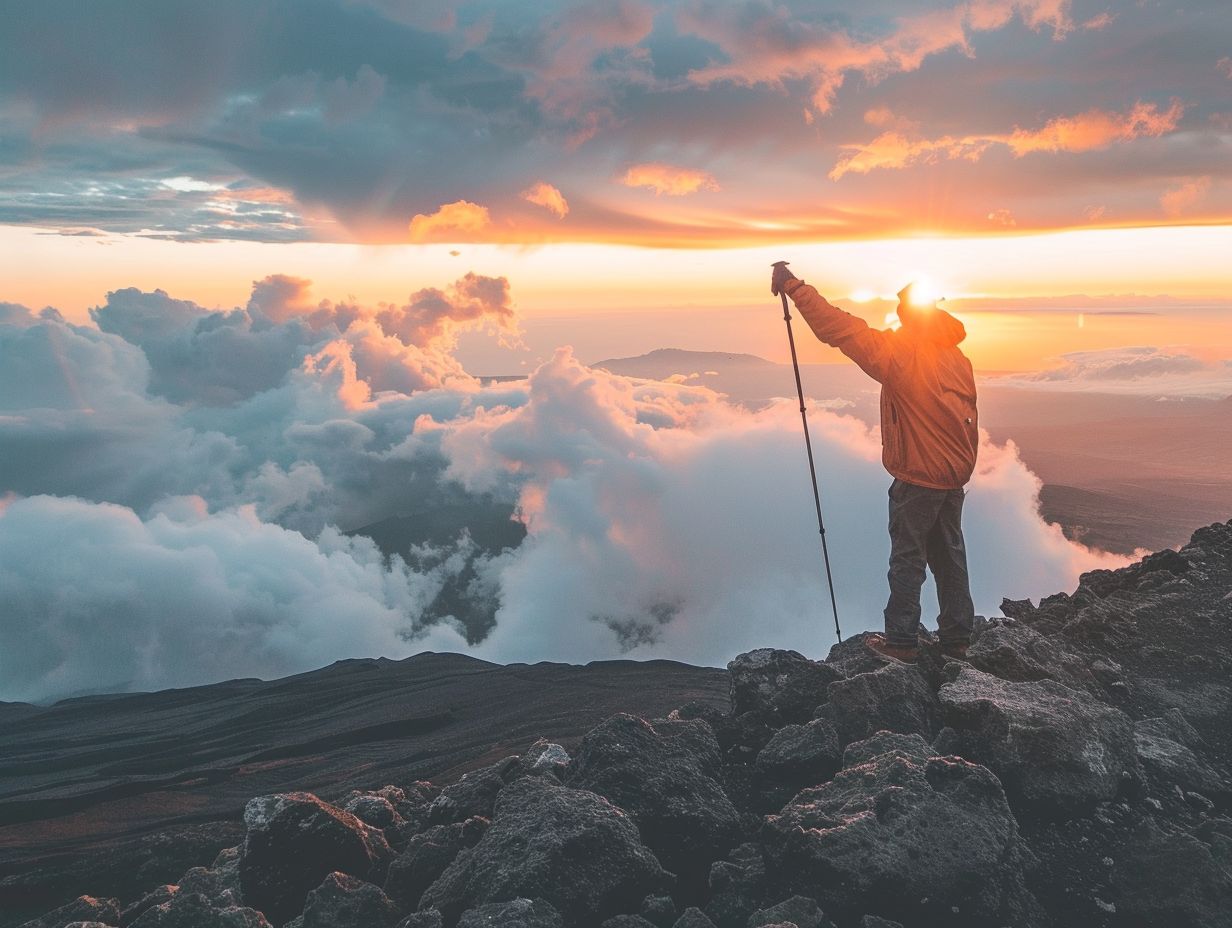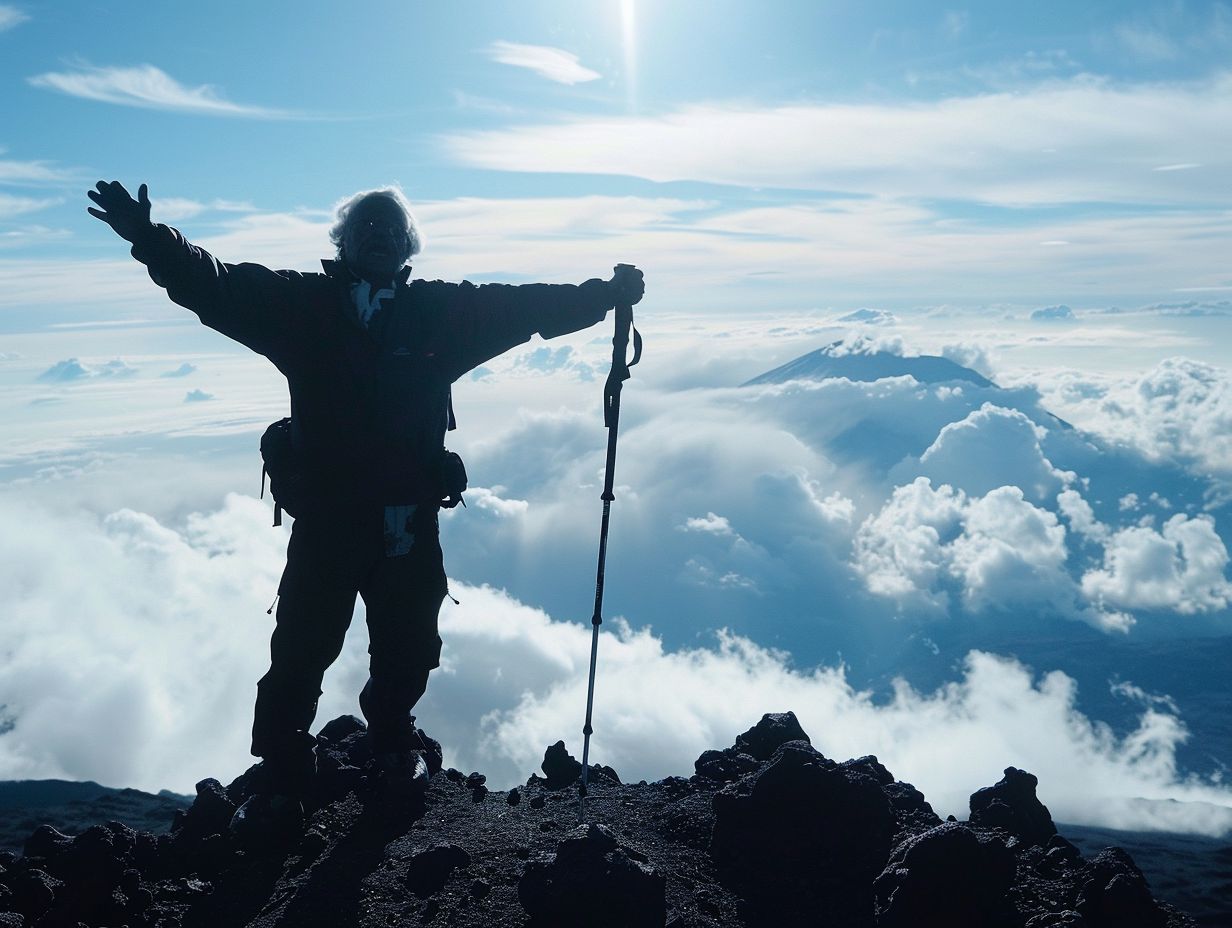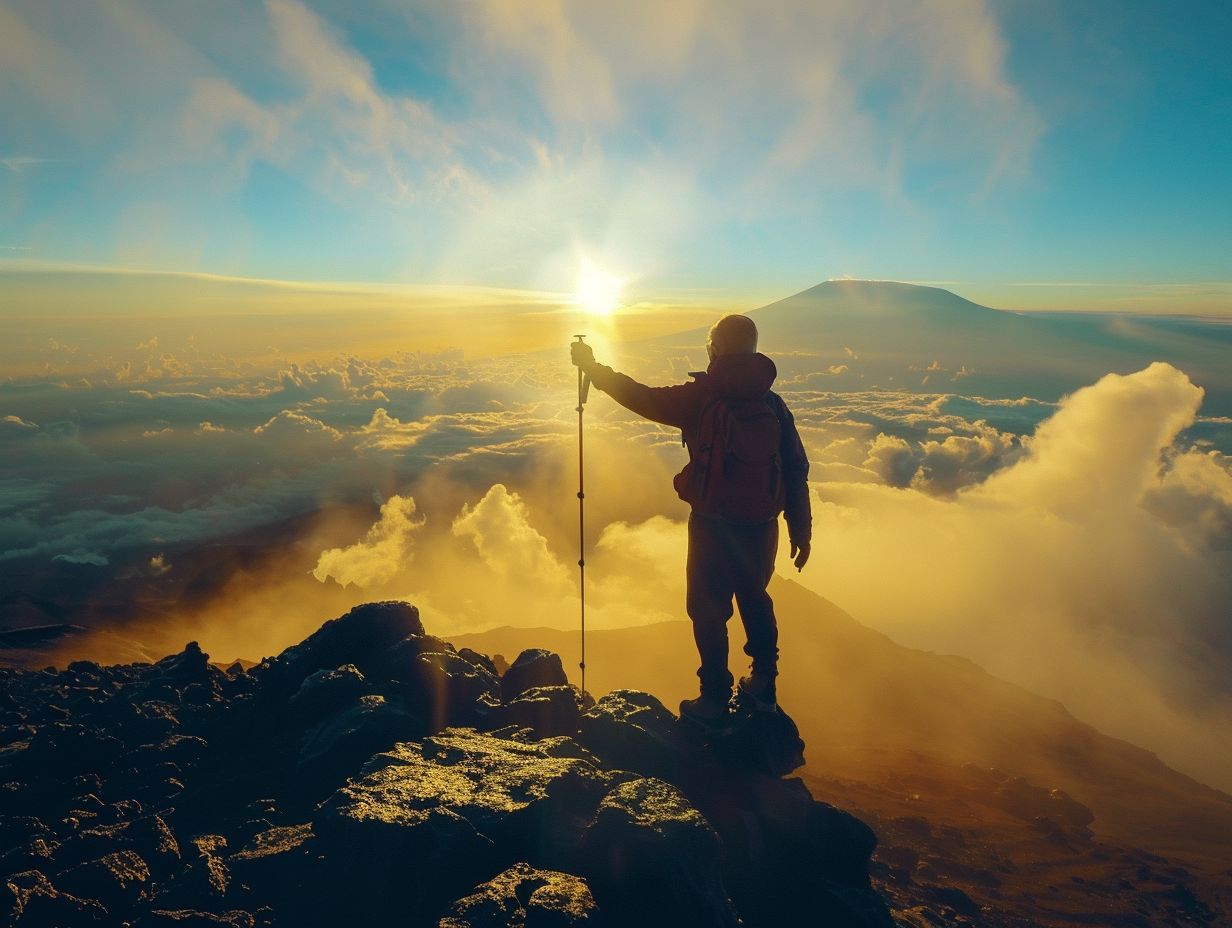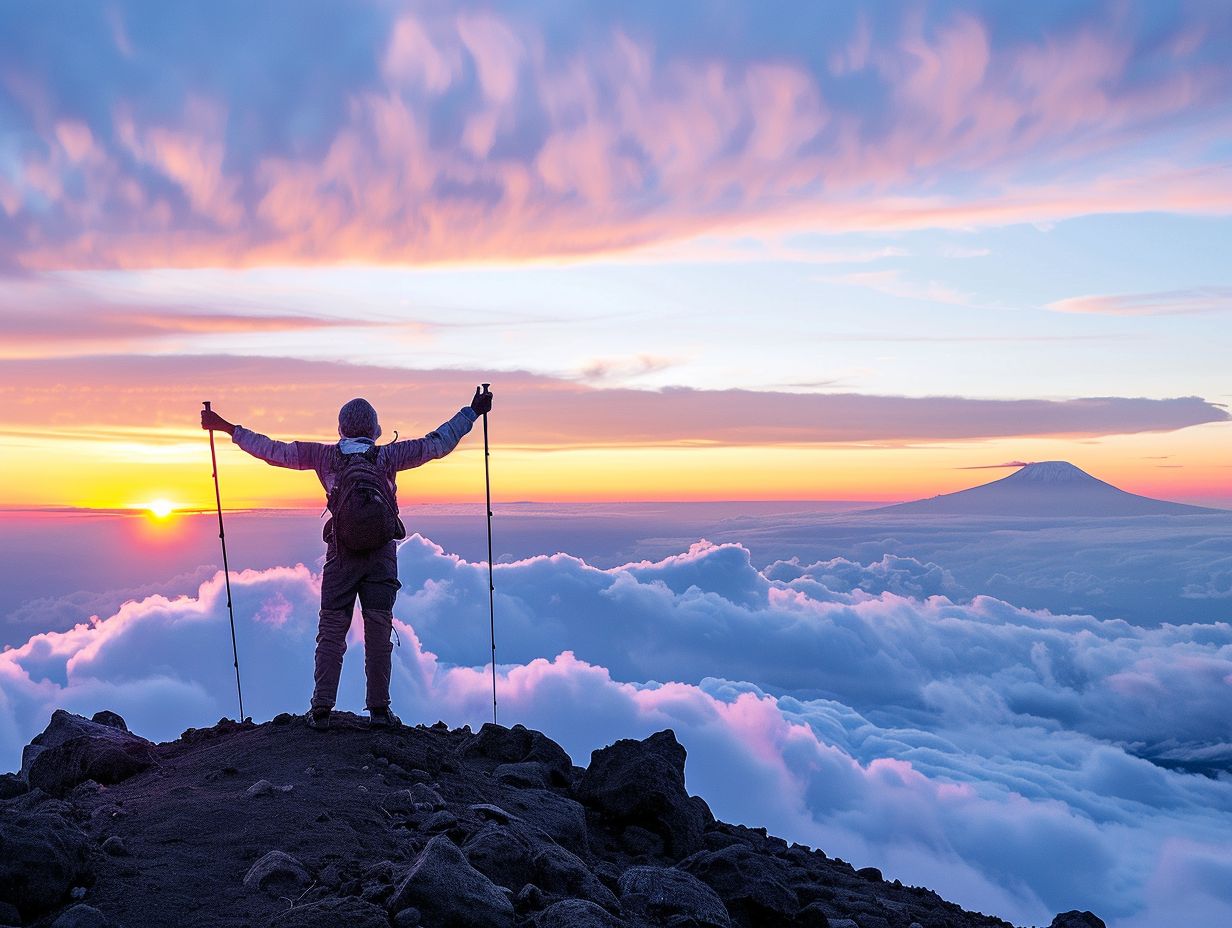
Oldest Person To Climb Kilimanjaro
Have you ever wondered who holds the record for being the oldest person to conquer Mount Kilimanjaro?
This article explores the incredible achievements of those who have climbed Africa’s highest peak at an advanced age.
We also discuss the physical and mental requirements needed to undertake this challenging feat, as well as the potential benefits of such an adventure.
Delve into the safety measures and preparation needed to ensure a successful climb. So, grab your gear and get ready to learn all about climbing Kilimanjaro!
Key Takeaways:

- The oldest person to climb Kilimanjaro was 87 years old, setting a record for the oldest person to summit the mountain.
- Physical and mental requirements, such as good physical health and mental strength, are necessary for a successful climb.
- Climbing Kilimanjaro poses challenges such as altitude sickness, extreme weather conditions, and physical demands, making safety measures and proper preparation crucial.
Who Is The Oldest Person To Climb Kilimanjaro?
The oldest person to summit Mount Kilimanjaro was Anne Lorimor, setting the record at an impressive age.
Anne Lorimor’s achievement of conquering Mount Kilimanjaro serves as a source of inspiration for many aspiring climbers worldwide. Her determination and resilience in the face of adversities showcased a remarkable display of human strength and perseverance.
Scaling Kilimanjaro is no small feat, with its towering height of 19,341 feet and challenging terrain presenting formidable obstacles to even the most experienced climbers.
Individuals like Angela Vorobeva and Robert J. Wheeler have proven that with dedication and passion, reaching the summit is within reach.
What Is The Record Age Of The Oldest Person To Climb Kilimanjaro?
The record for the oldest person to climb Mount Kilimanjaro is a remarkable achievement, showcasing the determination and spirit of adventurers.
One notable record holder is Anne Lorimor, who at the age of 89, conquered Kilimanjaro, inspiring many with her resilience and passion for adventure. Angela Vorobeva, aged 86, exemplifies unwavering dedication by reaching the summit, proving age is no barrier to success. Robert J. Wheeler, aged 85, displayed grit and perseverance as he achieved this feat, setting an example for aspiring climbers worldwide.
The significant accomplishments of these individuals serve as motivation for others seeking to conquer the majestic Mount Kilimanjaro, illustrating that age is not a limitation when it comes to pursuing dreams and embracing challenges.
What Are The Requirements To Climb Kilimanjaro?
Climbing Mount Kilimanjaro requires careful planning and preparation to conquer its majestic summit.
One of the crucial factors to consider when preparing for the ascent is choosing a suitable route, with the Rongai Route often recommended for its gradual incline and varying scenery. This route typically takes six to eight days, providing ample time for acclimatization to the elevation changes.
Physical fitness is essential as the trek to Uhuru Peak involves hiking for several hours each day, often in challenging conditions. It is vital to engage in regular cardiovascular and strength training to build endurance and strength for the climb.
-
What Are The Physical Requirements?

Physical fitness plays a crucial role in conquering Mount Kilimanjaro, requiring climbers to be in top condition for the challenging journey ahead.
Climbers attempting to summit Kilimanjaro must possess exceptional endurance to tackle long hours of trekking in varying terrains, ranging from lush rainforests to alpine deserts. The altitude gain as they ascend presents a significant challenge, demanding a strong cardiovascular system to cope with the decreased oxygen levels.
Muscular strength is vital for navigating steep inclines and rocky paths. Noteworthy climbers like Karl Egloff, known for breaking speed records for ascent and descent, exemplify the high fitness standards needed to achieve remarkable feats on Kilimanjaro.
-
What Are The Mental Requirements?
Successfully climbing Mount Kilimanjaro requires mental strength and resilience to overcome the various challenges posed by the trek.
Among the key mental attributes needed are determination, focus, and perseverance. These qualities are essential to combat altitude sickness, navigate through unpredictable weather conditions, and endure physical exhaustion during the demanding ascent.
Climbers who have etched their names in the annals of the Guinness World Records for mental fortitude serve as inspirations for those aiming to conquer Kilimanjaro. Their unwavering resolve in the face of extreme adversity showcases the power of the human mind when pushed to its limits.
What Are The Challenges Of Climbing Kilimanjaro?
Climbing Kilimanjaro presents a series of challenges that test climbers both physically and mentally throughout their expedition.
One of the primary challenges climbers face on Kilimanjaro is dealing with altitude sickness, also known as acute mountain sickness (AMS). This condition occurs when the body fails to acclimatize properly to the decreasing oxygen levels at higher altitudes. It can lead to symptoms such as headaches, nausea, and fatigue, making the ascent even more grueling.
The weather on Kilimanjaro is notoriously unpredictable, with drastic changes in temperature and sudden storms posing hazards to climbers. The sheer physical demands of the climb, including steep ascents and long hours of trekking, require exceptional endurance and strength.
-
What Is The Altitude Sickness?

Altitude sickness, a common challenge when climbing high mountains like Kilimanjaro, can affect climbers’ well-being and performance during the ascent.
It occurs when ascending to high altitudes too quickly, leading to a decrease in the oxygen available at higher elevations. Symptoms of altitude sickness can include headaches, nausea, fatigue, and dizziness, making it crucial for climbers to acclimatize properly.
Factors such as rapid elevation gain, dehydration, and individual susceptibility contribute to the onset of altitude sickness. Experienced climbers and guides recommend gradual ascent, proper hydration, and adequate rest to prevent and manage altitude sickness effectively during the expedition.
-
What Is The Weather Condition?
The weather conditions on Mount Kilimanjaro can be unpredictable and severe, posing a significant challenge for climbers at various altitudes.
At lower elevations, climbers may encounter warmer temperatures, sometimes reaching up to 30°C (86°F) during the day. As they ascend, the mercury dramatically drops, with summit temperatures often plummeting well below freezing.
- Precipitation is another major factor to contend with on the mountain. Rain is common at lower levels, transforming into snow and sleet as climbers approach higher altitudes. This shift in weather patterns can make each part of the ascent uniquely challenging.
- Relentless wind speeds can buffet climbers at exposed sections, adding an additional layer of difficulty to the climb. These varying weather conditions underscore the importance of proper gear and preparation to ensure climbers are equipped to handle the harsh elements they may encounter on their journey up Kilimanjaro.
-
What Are The Physical Demands?
Climbing Kilimanjaro demands significant physical strength and endurance due to the high elevation and rugged terrain encountered along the ascent.
Endurance plays a crucial role in conquering the various routes up the mountain, with hikers often facing long, arduous hikes spanning several hours or even days. The constant uphill climbs, rocky pathways, and fluctuating weather conditions test the climbers’ stamina and mental fortitude.
Muscle strength is another essential component, especially when tackling challenging sections like steep inclines or navigating through rocky outcrops. Strong leg muscles are vital for maintaining stability and power during difficult stretches of the climb.
The high altitude on Kilimanjaro presents a unique challenge, as the reduced oxygen levels can impact physical performance. Climbers need to acclimatize gradually to prevent altitude sickness and ensure their bodies can cope with the decreased oxygen availability.
What Are The Benefits Of Climbing Kilimanjaro?
Climbing Kilimanjaro offers a plethora of benefits, both physical and mental, to those who undertake the rewarding journey to the summit.
Ascending the stunning peaks of Kilimanjaro not only contributes to increased physical fitness and endurance but also serves as a transformative experience for the mind. The rigorous trek up the mountain challenges climbers both physically and mentally, fostering resilience and determination.
Many climbers find that conquering Kilimanjaro instills a profound sense of accomplishment, boosting their confidence and self-belief. Taking on such a monumental feat can be a life-changing experience, leading to personal growth and a newfound appreciation for the beauty of nature.
-
Physical Benefits:
Climbing Kilimanjaro yields numerous physical benefits, including enhanced cardiovascular fitness, muscle strength, and endurance, making it a rewarding challenge for those seeking to improve their physical health.
Ascending Kilimanjaro not only tests your mental fortitude but also transforms your body in remarkable ways. The high-altitude trek demands high levels of cardio performance, pushing your heart and lungs to work at increased capacity, thereby enhancing your cardiovascular health.
Navigating the rugged terrain and steep inclines helps tone your muscles, particularly in the legs, core, and upper body. The continuous physical exertion, especially at heights, contributes to building endurance levels that can be beneficial in various other physical activities.
-
Mental Benefits:
The mental benefits of climbing Kilimanjaro are profound, fostering resilience, determination, and a sense of achievement that can positively impact climbers long after the expedition is over.
As climbers ascend the magnificent slopes of Kilimanjaro, they are faced with physical challenges that test their limits, pushing them beyond what they thought possible. It is the mental fortitude gained from conquering this iconic peak that often leaves the most lasting impression.
Self-confidence flourishes as climbers overcome obstacles and push through moments of doubt. The perseverance required to reach the summit instills a deep sense of confidence that translates into their everyday lives, give the power toing them to tackle new challenges with a renewed vigor.
- One climber, Sarah, shared how summiting Kilimanjaro changed her outlook on life, providing her with a newfound sense of inner strength and determination that she carries with her in all aspects of her life.
- Another climber, John, described how the journey up the mountain taught him the importance of setting goals and working towards them steadily, a lesson that he now applies to his professional endeavors with remarkable success.
Conquering Kilimanjaro is not just about reaching the peak; it is about the transformative journey that shapes the mind and spirit, leaving climbers with invaluable mental tools that serve them long after the descent.
What Are The Safety Measures To Take When Climbing Kilimanjaro?
Ensuring safety during a Kilimanjaro climb is paramount, requiring thorough preparation, qualified guidance, and adherence to essential safety measures.
One of the critical safety measures for a successful Kilimanjaro ascent is the provision of appropriate gear and equipment. The proper clothing, footwear, backpacks, and camping gear can make a significant difference in the comfort and safety of climbers throughout various weather conditions and terrains.
Moreover, experienced guides play a pivotal role in ensuring the safety of climbers. Their knowledge of the mountain, weather patterns, and emergency protocols can be invaluable in navigating challenges and emergencies that may arise during the climb.
Comprehensive training and preparation are also essential. Climbers must be physically fit, mentally prepared for the altitude, and equipped with the necessary skills to handle the demands of the climb.
-
Proper Gear And Equipment:

Selecting and carrying the right gear and equipment is crucial for climbers to navigate the challenges posed by Kilimanjaro’s diverse terrain and fluctuating weather conditions.
When preparing for a Kilimanjaro expedition, one of the most important items on the packing list is appropriate clothing. Dressing in layers to accommodate temperature fluctuations is key, so be sure to pack thermal base layers, insulating mid-layers, a waterproof jacket, and sturdy hiking pants.
High-quality socks and gloves are essential to protect against frostbite and keep extremities warm. Proper hiking boots with ankle support and traction are a must for navigating rocky paths and slippery surfaces.
Another crucial piece of equipment for a Kilimanjaro climb is a sturdy and reliable tent. This provides shelter during the nights on the mountain and a place to rest and recover after long days of trekking.
Make sure the tent is lightweight yet durable to withstand the challenging conditions at higher altitudes. Safety gear such as a headlamp, trekking poles for stability, a first aid kit, and a portable water filtration system are vital for ensuring a safe and successful ascent.
-
Experienced Guide:
Engaging the services of an experienced guide is vital for climbers attempting to summit Kilimanjaro, as their knowledge, expertise, and guidance can enhance safety and optimize the overall climbing experience.
Having a seasoned guide by your side in the challenging terrain of Kilimanjaro is like having a reliable compass in a vast wilderness — they provide direction, insight, and a crucial level of assurance. These guides, often native to the region, possess an intimate understanding of the mountain’s quirks and nuances, which significantly increases the chances of a successful ascent.
Their mountaineering skills are honed through years of experience, enabling them to navigate treacherous passages, handle unexpected challenges with confidence, and set a sustainable pace for climbers to follow. In moments of crisis or emergencies, their training and swift response capabilities can make all the difference between a smooth rescue operation and a potential disaster.
-
Proper Training And Preparation:
Thorough physical training and mental preparation are essential components of successfully climbing Kilimanjaro, enabling climbers to build the necessary endurance, strength, and resilience for the arduous journey ahead.
Physical fitness regimens play a crucial role in preparing the body for the demands of high-altitude trekking. Endurance training, such as cardio exercises and long hikes, helps improve cardiovascular health and stamina. Strength training focusing on core muscles and lower body strength contributes to stability on rocky terrain.
Mental conditioning exercises, including visualization techniques and stress management practices, aid in developing a resilient mindset to cope with challenging conditions. Acclimatization strategies, such as gradual ascent and rest days at higher altitudes, help prevent altitude-related illnesses and allow climbers to adapt to lower oxygen levels.
How To Prepare For Climbing Kilimanjaro?
Proper preparation is key to a successful Kilimanjaro climb, encompassing physical training, mental readiness, and meticulous packing to ensure a safe and rewarding adventure.
Regarding physical training, it’s crucial to focus on building endurance, strength, and cardiovascular fitness. Incorporate regular hiking, running, and strength training into your routine. Simulate high-altitude conditions through activities like stair climbing or using a treadmill with an incline.
Mental preparation is equally important; practice mindfulness, visualization, and positive affirmations to cultivate a resilient mindset.
As for gear, invest in quality breathable clothing, sturdy boots, a reliable backpack, and essential items like a sleeping bag, headlamp, and water purification tablets. Packing smartly with necessities and staying organized are key to navigating the challenging terrain of Kilimanjaro.
-
Physical Training:
Physical training tailored to the demands of Kilimanjaro, including cardiovascular exercises, strength training, and hiking practice, is vital for climbers to build the necessary fitness and stamina required for the ascent.
Cardiovascular exercises like running, cycling, and hiking help improve the heart’s efficiency and endurance for sustained physical exertion at high altitudes. Incorporating interval training can mimic the varying intensities of the climb.
Strength training focusing on core, leg, and upper body muscles will enhance stability and power for navigating steep slopes and carrying gear.
Regular hiking practice on inclines or wearing a weighted backpack prepares climbers for the endurance and terrain challenges they’ll face on Kilimanjaro.
-
Mental Preparation:
Mental preparation is essential for Kilimanjaro climbers, requiring focus, determination, and a positive mindset to navigate the physical and mental challenges encountered during the expedition.
One effective strategy to foster mental resilience is visualization. Many successful climbers visualize themselves reaching the summit, feeling the sense of accomplishment and joy. This technique helps in reinforcing confidence and reducing anxiety. Setting small achievable goals along the way can boost morale and motivation.
Overcoming fears is another crucial aspect; acknowledging fears, breaking them down into manageable parts, and gradually facing them head-on can help conquer them. The journey up Kilimanjaro is not just physical but also a test of mental fortitude.
-
Packing And Gear Preparation:
Proper packing and gear preparation are essential aspects of readiness for a Kilimanjaro climb, ensuring climbers have the necessary equipment, clothing, and supplies to tackle the challenges of the expedition.
When packing for a Kilimanjaro adventure, it’s crucial to prioritize functionality and versatility in your gear selection. Opt for moisture-wicking clothing that provides warmth and protection against varying weather conditions. Durable and comfortable footwear with excellent traction is essential for navigating the diverse terrain.
As you plan your packing list, be mindful of the importance of lightweight camping equipment that doesn’t compromise on durability. Personal supplies such as sunscreen, lip balm, and high-energy snacks are also vital additions to your kit.
Frequently Asked Questions:
1. Who is the oldest person to climb Kilimanjaro?
A: The oldest person to climb Kilimanjaro is Angela Vorobeva, who was 86 years old when she reached the summit in 2019.
2. What age do you need to be to climb Kilimanjaro?
A: There is no specific age requirement for climbing Kilimanjaro, but it is recommended that climbers be at least 18 years old.
3. How long does it take to climb Kilimanjaro?
A: The average time to climb Kilimanjaro is around 7-9 days, but this can vary depending on the route and individual fitness levels.
4. What is the success rate for older climbers on Kilimanjaro?
A: The success rate for older climbers on Kilimanjaro is lower compared to younger climbers, with only about 20% of those over the age of 60 reaching the summit.
5. Are there any age-related health concerns for climbing Kilimanjaro?
A: Yes, older climbers may be more prone to altitude sickness and other health issues due to their age. It is important to consult with a doctor and prepare physically before attempting to climb Kilimanjaro.
6. How can older climbers increase their chances of reaching the summit of Kilimanjaro?
A: Proper preparation, training, and choosing a suitable route are all important factors for older climbers to increase their chances of reaching the summit. It is also recommended to hire an experienced guide and porter to assist with the climb.